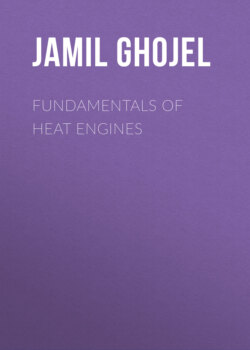Читать книгу Fundamentals of Heat Engines - Jamil Ghojel - Страница 60
1.3.7 The Carnot Principle
ОглавлениеNicolas Sadi Carnot (1796–1832) was a French engineer who made significant contributions to the science of thermodynamics by recognising that heat engines must operate with cyclic processes. A cycle occurs when a thermodynamic system, having undergone a series of processes, arrives at a final state that is exactly the same as its initial state. In Carnot's own words (Sandfort, 1964): ‘The thermal agency by which mechanical effect may be obtained is the transference of heat from one body to another at a lower temperature’. Carnot also investigated the problem of determining the maximum work that can be extracted from the transfer of heat from high to low temperature. He eventually came up with a definition of a perfect thermodynamic engine as follows: ‘Whatever amount of mechanical effect it can derive from a certain thermal agency, if an equal amount be spent in working it backwards, an equal reverse thermal effect will be produced’. Such an engine has come to be known as the reversible engine, and the quotation as the Carnot principle. Furthermore, Carnot stated that the maximum limits of temperature between which any actual heat engine can work are the temperature of combustion of fuel and the temperature of the coldest body we can easily find and use in nature, usually the water in rivers and lakes. Figure 1.15a is the Carnot engine, and the Carnot cycle is shown in Figure 1.16 in p − V and T − s coordinates:
Process 1–2: Isothermal expansion (pV = const.) with heat addition
Process 2–3: Reversible adiabatic expansion (pVγ = const)
Process 3–4: Isothermal compression (pV = const) with heat rejection
Process 4–1: Reversible adiabatic compression (pVγ = const)
Figure 1.16 Ideal Carnot engine cycle in (a) p‐V and (b) T‐s coordinate systems.
Thermal efficiency of this heat engine is
(1.89)
Since Eq. (1.89) is obtained without reference to a specific working fluid, it can be surmised that all reversible cycles operated between the same temperatures will have the same thermal efficiency.
Based on accumulated experimental knowledge, scientists and engineers have come to the conclusion that it is impractical to build the Carnot engine, and it remains to date as the ideal cycle against which real heat engine cycles are measured. If such an engine were to operate between combustion temperature of iso‐octane (gasoline) TH = 2300 K and the standard ambient temperature TL = 298.15 K, the Carnot efficiency would be 78%. By comparison, the most efficient reciprocating internal combustion engines can hardly achieve 50%.
